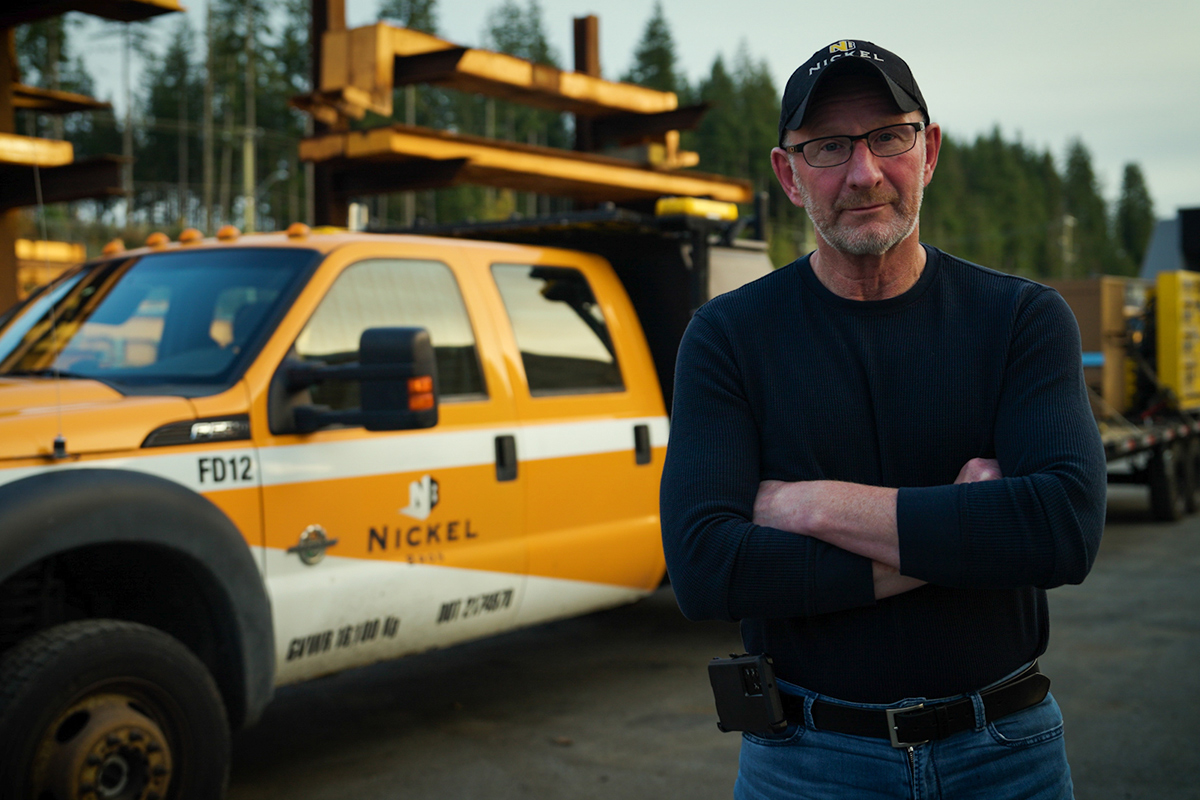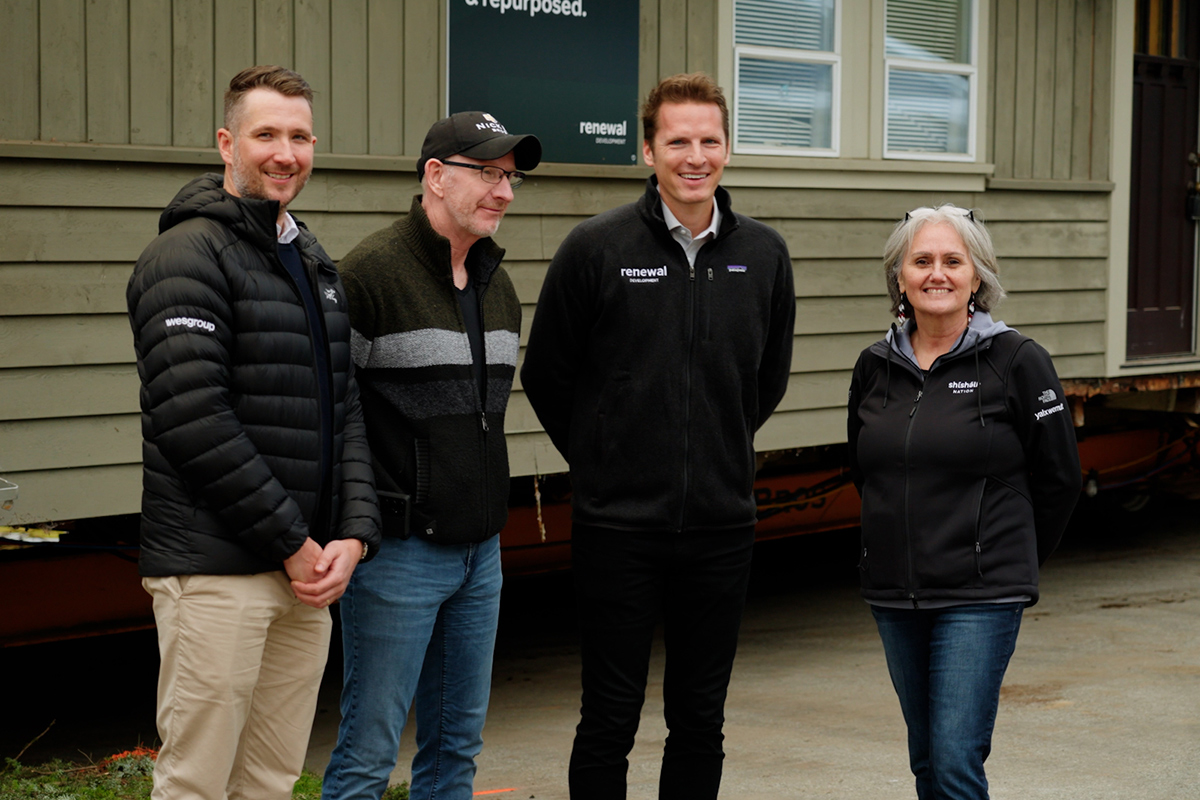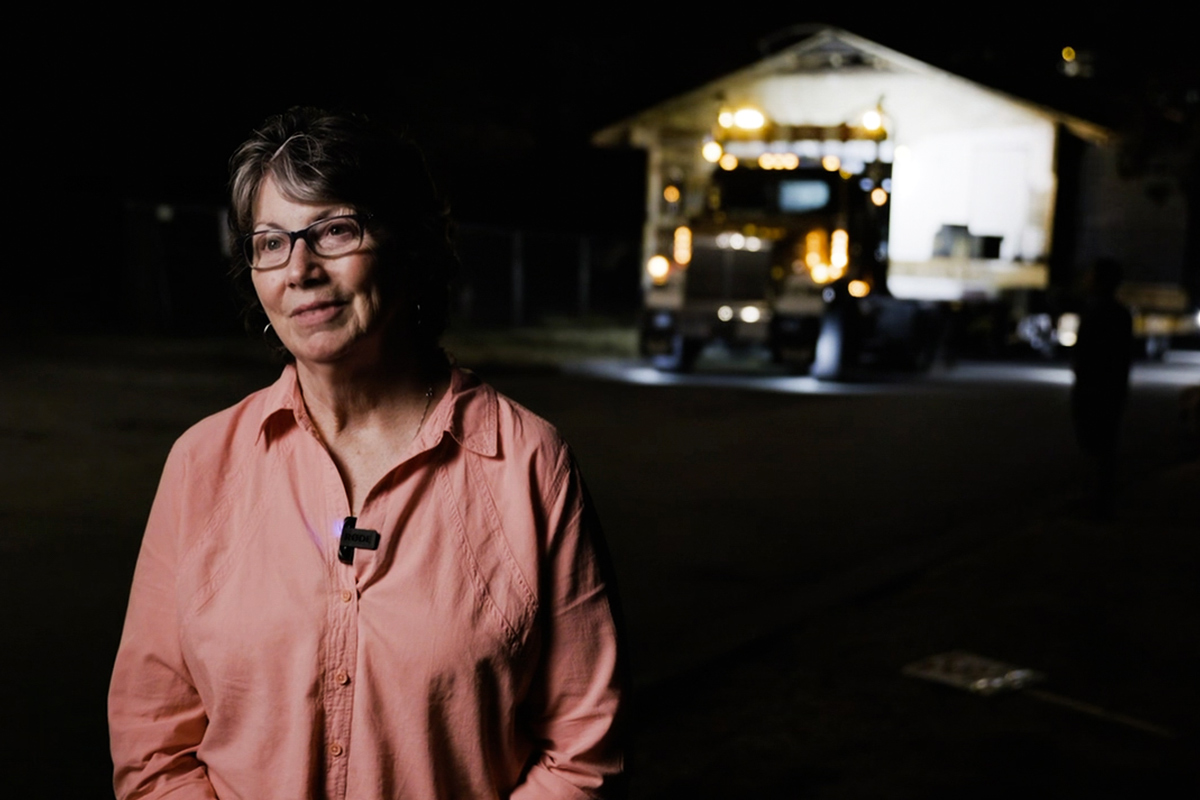June 13, 2025
00:00:02
Glyn: Every year, 2,700 homes are being torn down across Metro Vancouver to make space for higher-density development.
(Visual: A bird’s-eye view of Metro Vancouver. The camera cuts to a locked fence, outside real estate signs on various houses and a development application sign, then a tractor digging on a property with a female onlooker watching what’s going on. The camera cuts to a bird’s-eye view of tractors digging up land.)
00:00:13
Glyn Lewis, CEO/Founder – Renewal Development: We estimate about 700 of those homes are in perfectly good condition, and all of those homes are ending up in our landfills right now.
(Visual: The camera cuts to Glyn Lewis talking, then to an aerial shot of tractors and home demolitions.)
00:00:24
Glyn: It’s incredibly wasteful. From a climate change perspective, it’s also incredibly wasteful. There are responsible alternatives to demolition.
(Visual: The camera cuts to more graphic house demolitions.)
00:00:32
(Text on screen: A Second Chance, Saving single-family homes from the landfill)
(Visual: The camera cuts to a boat transporting a home.)
00:00:41
Darlene Hadden, former homeowner – Port Moody: We moved to the house in Coronation Park almost 40 years ago with a son and daughter. They were 7 and 9 years old. When we saw the house, it was a beautiful house. And the yard looked like a park, when we went out the backyard. We couldn’t believe that we were so lucky to get that house. Every Christmas Eve was family and friends. Any birthdays or graduation, weddings, we filled the house with family and friends, which I love to do.
(Text on screen: Darlene Hadden, Former Homeowner – Port Moody)
(Visual: The camera cuts to street signs of Port Moody. The camera cuts to a far shot of the city and water by a dock. The camera cuts to pictures of Darlene’s backyard with potted flowers, then pictures of Darlene’s house, Darlene’s family at Christmas, Darlene’s family on birthdays, graduation pictures and wedding photos.)
00:01:14
Glyn: The Government of Canada, the provincial government, local governments have been really promoting the densification of our urban areas to create the housing that we need so that we don’t have this shortage and we don’t have all of this inflationary pressure on housing costs.
(Text on screen: Glyn Lewis, CEO/Founder – Renewal Development)
(Visual: The camera cuts to Glyn Lewis sitting in his office, talking. The camera cuts to a Wesgroup sign, then a high-rise building on a corner, then a large sign reading “Inlet District.” The camera cuts to a wall with the words “Wesgroup” and “Homes coming soon.”)
00:01:29
Dean Johnson, Senior Vice President, Development – Wesgroup: Land assemblies are a more common practice. So, you’re taking an area that primarily has been a suburban, single-family-home neighbourhood, and with the advent of rapid transit connections or other infrastructure, we’re looking at densifying some of those suburban or more urban cores around the Lower Mainland.
(Text on screen: Dean Johnson, Senior Vice President, Development – Wesgroup)
(Visual: The camera cuts to Dean Johnson in his office, talking. The camera cuts to traffic, high rises and then a bird’s-eye view of the city.)
00:01:46
Darlene: We didn’t want to sell at all. We just wanted to stay where we were, after being settled in this house for so long and thinking you’re staying there forever.
(Visual: The camera cuts to an old photo of Darlene’s neighbourhood, then a picture of an old road.)
00:01:58
Dean: As a company, that is, we’re all about our people and the potential we see in our people. It was important for us to understand what those homes meant to the individuals. There were a lot of emotional conversations around, not necessarily leaving, but the good memories that those homes had for the individuals who had made them their lives for decades.
(Visual: The camera cuts to a bird’s-eye view of land alongside a highway. The camera cuts to a forest with cleared land where a home used to be. The camera cuts to Dean Johnson talking. The camera cuts to Darlene touching the wall of her home with names all over it. Darlene smiles at the camera.)
00:02:17
Glyn: I support the densification of our urban areas, especially given that we’re in a housing shortage crisis. The challenge is that the process to achieve that density is unbelievably wasteful. I went into a boardroom with Wesgroup and I said, “Listen, you’ve got this massive land assembly. You know, you’re going to pay a demolition company to tear down 60 single-family homes. There looks to be at least 10 that seem to be in perfectly good condition.” Instead of demolishing these 10 homes, our mission as a company is to physically lift, relocate and repurpose for communities in need of good housing.
(Visual: The camera cuts to Glyn sitting, talking. The camera cuts to a replica of a high rise replete with little human figures, with an “Inlet District” sign at the bottom of the high rise’s entrance. The camera cuts to video of the Inlet District. The camera cuts to a fenced area of land with an “Inlet District” sign on the fence. The camera cuts to the exterior of a house, then other houses. The camera cuts to building machinery setting up to lift homes with workers inside the home placing the equipment.)
00:02:54
Chief Lenora Joe, Shíshálh Nation: Housing is urgent right now in our community. We have over 200 people who are on the housing list. As well, most of our homes have two or three families living in 1 three-bedroom home. We need homes; that’s our priority. This is one of the easiest, quickest, most sustainable ways we can do this project.
(Text on screen: Chief Lenora Joe, Shíshálh Nation)
(Visual: The camera cuts to Chief Lenora inside, talking. The camera cuts to a house half loaded onto a truck. The camera cuts to a truck slowly moving with a home on its back. The camera cuts to a far shot of a boat with a home on it, on the ocean.)
00:03:21
Glyn: We had great partners all around the table to pull this project off, Wesgroup agreeing for Renewal to act as the responsible removal service provider. And then it was the Shíshálh Nation, they could have built new, or they could have got modular homes or prefab homes. But we worked through the numbers and we looked through the feasibility and the quality of these homes, and it turned out to be more affordable. And Nickel Brothers, obviously their professionalism in moving big structures… I think they’re some of the best at this in North America, if not in the world.
(Visual: The camera cuts back to Glyn in the office with a picture in the background of a home being transported on a boat. The camera cuts to a close-up of Glyn typing on a laptop. The camera cuts to Dean in the office at a desktop computer with an Inlet District coffee mug. The camera cuts to a picture of four Shíshálh Nation people singing and beating drums, then a shot of Chief Lenora, Glyn, Dean and Jeremy. The camera cuts to someone taking a picture with a camera of a group standing beside a house that is loaded onto a truck for transportation. The camera cuts to a Nickel Bros sign on a wall outside. The camera cuts to truck equipment. The camera cuts to Jeremy and a receptionist at a computer.)
00:03:52
Jeremy Nickel, President – Nickel Bros: We have such an affordability issue right now in terms of housing. We feel like our moved homes, repurposed homes really address both the affordability and the sustainability issues.
(Text on screen: Jeremy Nickel, President – Nickel Bros)
(Visual: The camera cuts to Jeremy Nickel in his office. The camera cuts to Jeremy getting into a company truck.)
00:04:06
Glyn: CMHC and the Housing Supply Challenge, they saw the opportunity for me to bring in some innovation and then for that to be replicated and scaled. I want to be moving 200 to 300 homes a year. And I think we can.
(Visual: The camera cuts to Glyn in his office talking, then on his laptop, focusing onto an emblem on the laptop that says “Renewal Development.” The camera cuts back to Glyn smiling at the camera.)
00:04:22
Dean: The overwhelming sense that we did the right thing, and we knew we were doing the right thing, but to see it on people’s faces and see the appreciation, I think was pretty special.
(Visual: The camera cuts to Dean in his office. The camera cuts to Dean smiling at the camera.)
00:04:31
Jeremy: What has always amazed me is that when we’re moving a home, the entire community will come out to watch in the middle of the night. And I’ve determined that there is some sort of a romantic attachment to homes. There’s something about the soul of a home.
(Visual: The camera cuts to Jeremy in his office, talking. The camera cuts to Jeremy standing outside beside a company truck. The camera cuts to people at nighttime watching a home be transported away by a truck.)
00:04:46
Darlene: When we learned the house was going to a new community, we felt like our house was going to have life still and move on. We felt like the luckiest people.
(Visual: The camera cuts to a boat with a transported house on it, pulling off into the water. The camera then cuts to Darlene, smiling at the camera.)
00:04:56
(Visual: The camera cuts to a boat with a transported house on it, pulling off into the water. It then cuts to 2 different shots of a house on piles, indicating that it has been relocated.)
(On-screen text: Saved from demolition.)
(On-screen text: Relocated for purpose.)
(On-screen text: Rebuilt for community.)
00:05:11
(The screen fades to white, with the Renewal Development logo in black and the following text above it: Supporting footage provided by Renewal Development. This text and logo disappear and the bilingual CMHC-SCHL logo appears at the top of the screen, which is still a white background. The CMHC-SCHL logo moves to the left, and the Canada Wordmark (Government of Canada logo) appears beside it, to the right.)
At a glance
- Renewal Development partners with developer and moving company to save homes in Western Canada’s largest land assembly.
- Nickel Bros moves 10 homes by trailer and barge to shíshálh Nation where they will provide affordable housing for families in need.
- Homeowner Darlene Hadden watches as her home leaves her neighbourhood on a trailer.
Darlene Hadden could not have been happier to learn about Glyn Lewis’ plan for her former home in Coronation Park.
“When we learned the house was going to a new community…we felt like the luckiest people,” says Darlene. “We felt like our house was going to have life still. I was thrilled, just thrilled to find that out.”
Partners with a shared focus
Having secured the contract as Wesgroup’s ‘removal service provider,’ sustainable developer Glyn Lewis reached out to Jeremy Nickel, CEO and owner of Nickel Bros home moving company.
The family-owned business has been moving homes around the Pacific Northwest for 70 years.

“We move buildings, large structures, machinery. Anything that’s big and obstructive,” says Jeremy Nickel.
Jeremy took over the business from his father in the 1980s and has witnessed shifting trends in home relocation.
“Typically, most of the buildings that we move range between 40 to 50 years old. The ‘50s and ‘60s homes especially seem to be very well-built.
In the last 10 years, especially with densification and the need for more housing in urban areas [it] is actually causing many newer homes to be demolished and that's where we step in and rescue them.”
[WATCH] Jeremy describes Nickel Bros’ mission to give quality homes a second chance
Nickel Bros’ ‘purpose to re-purpose’ made them Renewal’s ideal partner for the Coronation Park project.
Moreover, Glyn and Jeremy were not strangers. They connected several years earlier, when Glyn’s sister needed to save her own home from the landfill.
[WATCH] Glyn discusses the genesis of Renewal Development
Together, Glyn and Jeremy walked through the Coronation Park homes and assessed which ones were suitable for relocation. Their considerations included:
- structural integrity
- hazardous materials
- modernization requirements
- moveability
Fast, affordable solution for coastal community
shíshálh Nation is located around 50km northwest of Vancouver and is in urgent need of housing.
“We have over 200 people who are on the housing list,” says Chief Lenora Joe.
“Most of our homes have 2 or 3 families living in one 3-bedroom home. We need homes. That's our priority.”
The community had been exploring various options but given their location, faced higher transportation, construction and labour costs than Vancouver or Victoria.
When Glyn approached the community with a proposal to receive existing homes, it was a good fit.

“They could have built new, or they could have got modular homes or prefab homes. But we worked through the numbers, and we looked through the feasibility and the quality of these homes and it turned out to be more affordable,” says Glyn.
For homes that were not selected for relocation, items including kitchen cabinets, appliances and bathroom fixtures were salvaged for re-use.
The pieces were finally in place.
“We had great partners all around the table to pull this off,” says Glyn.
Connecting with former residents
To ensure the security of the homes while they awaited removal, Glyn took an unusual step.
“I really believed in the project. I needed this to work. I didn't want someone going and tearing up all our homes. I thought that having some more presence on the site would be helpful.”
Glyn decided to move into one of the empty homes and used it as his live/work space.
While there, he met Rose McFarland and explained the plans for the vacant homes.
“…She was like, ‘Glyn, I think it's so wonderful and admirable what you're doing… I would love to introduce you to some of the former homeowners because I think this would mean a lot to them too.’”
[WATCH] Glyn connects with former homeowners
Moving day becomes community celebration
Many of the residents that Glyn connected with came out to watch their homes leave the neighbourhood, including Darlene.
“It was exciting, and it was sad, you know…to see your, the house and all your, your memories just go up the street on a trailer.”
Families, neighbours and friends lined the streets, watching from chairs and nearby balconies.
“We move submarines, we move large pieces of equipment, large ships and yet there’s not a lot of, I would say, attraction for the general public to want to watch these kinds of moves,” says Jeremy.
“There is some sort of romantic attachment to homes… something about the soul of a home.”
New beginnings
As shíshálh Nation installs the relocated homes, Renewal’s model is gaining momentum. Glyn is grateful to the support he has received from CMHC and the Housing Supply Challenge.
“They saw the opportunity for me to bring in some innovation, and then for that to be replicated and scaled…I want to be moving 2 or 3 hundred homes a year, and I think we can.”

“I feel so glad that there was so much interest by the First Nation and by Glyn to save our house and to not just throw it away,” says Darlene.
She did hold on to one piece—a door, etched with the heights of her children as they grew. She hopes the new occupants will find similar ways to make the house their own and can’t wait to meet them when the homes are complete.
“I feel really lucky that our house was chosen, that somebody else can start a life in it.”
Key facts
- Renewal Development was one of 16 finalists in Round 4 of CMHC and Impact Canada’s Housing Supply Challenge. The program challenges housing experts and professionals to develop innovative solutions to housing issues.
- The challenge is part of Impact Canada in collaboration with the Impact and Innovation Unit in the Privy Council Office and Infrastructure Canada.






 Share via Email
Share via Email
